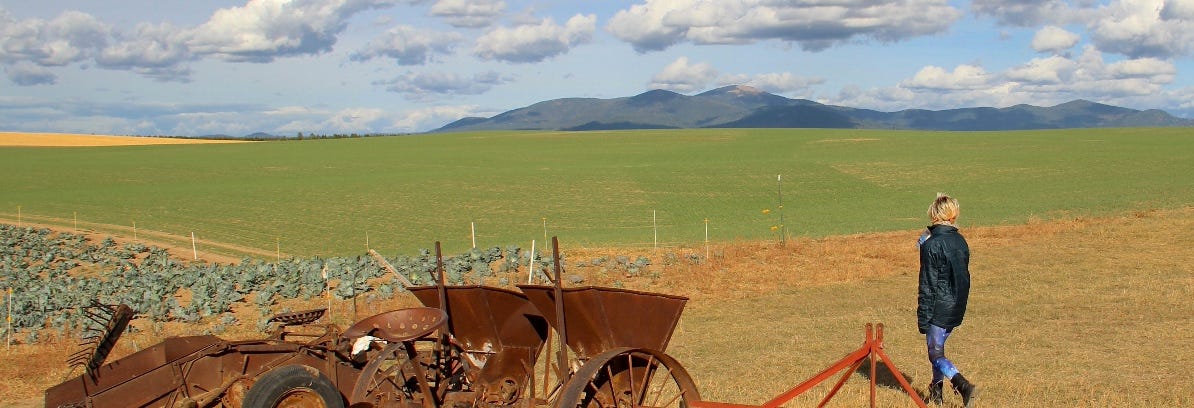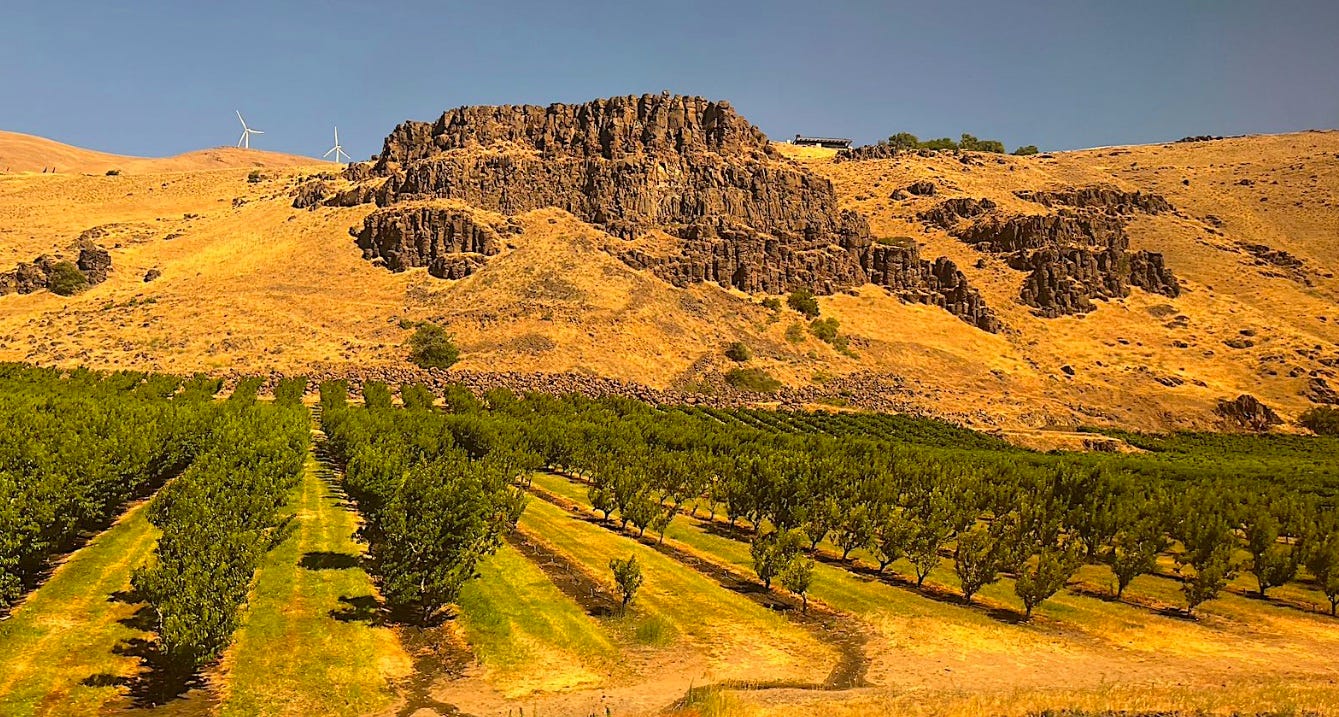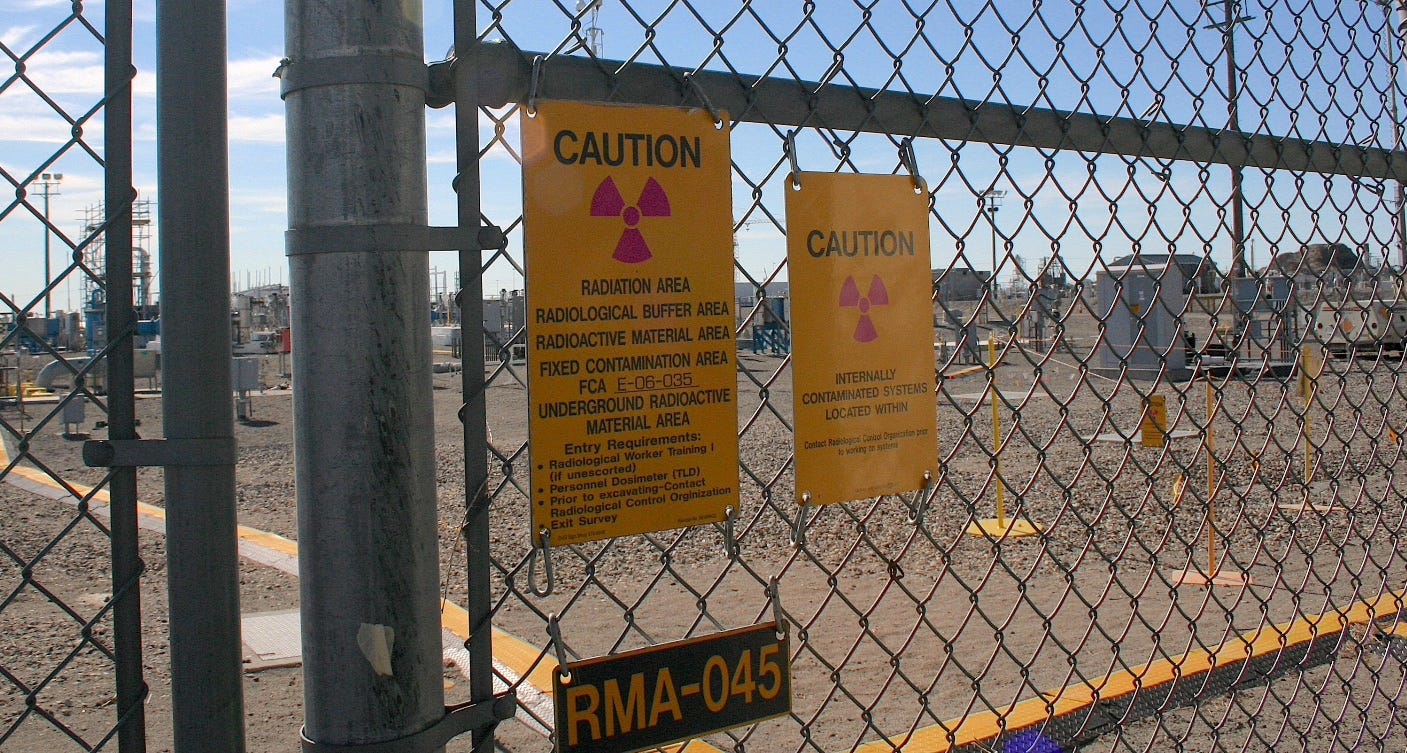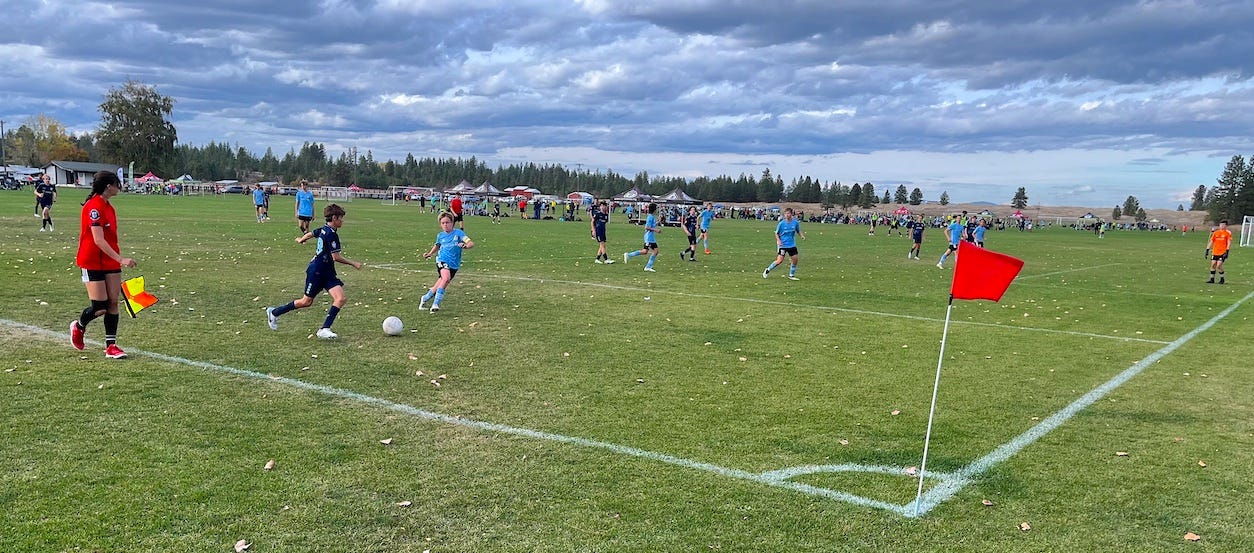Bubbles to the Sky (2023)
Before I get too deeply into today’s topic I wanted to give you a heads up on a guest piece Audrey has been working on. She won’t tell you this, but my dear daughter, in Portland, had four wisdom teeth removed. On Election Day. If you’ve had wisdom teeth removed you’re probably wincing as you’re reading this. She’s tough though and it’s no surprise (to me at least) that she emerged from the pain of the election and the extractions with something she just had to write about. I love that about her. I’m her father and (at least in this space) her editor, so I’ve seen the first draft. The final will be worth the wait. The kid can take a punch and—as a bully on her middle-school school bus learned 15 years ago— she can deliver one too.
Why Washington will weather Trumpism
To be candid, there have been no good days since November 5th.
But Monday night was inspiring. I went to an event in Airway Heights hosted by the West Plains Water Coalition (WPWC). The coalition had invited Alissa Cordner, one of the nation’s leadings experts on PFAS—the fiendishly toxic and long-lived synthetic chemical that has contaminated much of the groundwater west of Spokane.
With my recorder and note pads, I sat in the front row alongside Stan Miller, a legendary civil servant in these parts. It was Stan who, forty years ago, taught me about the Spokane Rathdrum Prairie Aquifer, from which the City of Spokane draws its exceptionally clean drinking water from a thick bed of cobbles entrenched in the Spokane valley. In contrast, the West Plains sits in a corner of what geologists call the Columbia River Basalt Group, the CRBG. It is layers of lava, most deposited 16 million years ago, like a birthday cake in which groundwater rather than frosting flows between the layers. In this quadrant of western Spokane County, thousands of people rely on groundwater in fractured basalt that is vulnerable to PFAS contamination emanating from Fairchild Air Force Base and nearby Spokane International Airport.
I was there to learn. Most of the people in the auditorium Monday night were there to learn too, but more urgently because their groundwater is contaminated, or may eventually be contaminated, with PFAS. The WPWC, over the past year and a half, has not only organized to represent the interests of West Plains residents threatened by the groundwater contamination, but to convene what is, in effect, a rolling seminar on science, history, and government. Across that range, Cordner is among the most qualified. She teaches at Whitman College in Walla Walla and is part of the leadership team of the PFAS Project Lab, a national organization expressly devoted to studying and empowering communities being affected by these fiendish toxics.
It was a good evening. I saw old and new friends, including two whom I’d worked closely with, a decade ago, on police oversight reforms in Spokane. I learned a lot.
Whitman College’s Alissa Cordner
I also had the sense that I’d been there before—not just in the past 18 months, but in the past forty years. In the early eighties my former editor and reporting partner Larry Shook and I leveraged a small grant from the Fund for Investigative Journalism to do a series of articles on Hanford’s then-active plutonium factories for two western Washington newspapers. Our reporting highlighted public health and safety concerns. But it was Hanford’s refusal to produce records we requested (which Hanford officials claimed to possess) that drew attention. It signaled a coverup. Our reporting didn’t appear in Spokane’s newspapers but was widely republished through xerography and distributed by volunteers for a nascent organization—the Hanford Education Action League (HEAL) founded by Spokane’s then-Unitarian minister (and former industry chemist) Bill Houff. Other journalists picked up the leads, including the Spokesman-Review’s brilliant investigative journalist, Karen Dorn Steele, whose subsequent reporting on Hanford’s emissions and reservoirs of radioactive wastes proved invaluable.
In 1985 I was hired to be the staff researcher for HEAL and was there in Richland, in the spring of 1986, when the Department of Energy finally declassified and released the documents Larry and I had sought two years earlier. Among other things, the records revealed that airborne emissions of radioactive iodine had contaminated milk throughout most of eastern Washington from the mid-1940s into the early 1950s. (My mother, a young girl in Pasco at the time, was one of the people who drank that milk and later developed thyroid disease.)
HEAL was one of several local and regional organizations that coalesced in response to the growing awareness of the severity of the contamination at Hanford. This statewide grassroots movement empowered Washington’s leaders—including former state Attorney General and later Governor, Chris Gregoire, to press for a comprehensive Hanford cleanup agreement (1989), one that became a national model for bringing U.S. nuclear weapons facilities into compliance with state and federal environmental laws.
A good soul by the name of Bill Mitchell (a proud Whitman College graduate) first organized a regional network from Seattle. He then expanded it, nationwide, to become what is now the national Alliance for Nuclear Accountability (ANA). He died, too early, in 2016.
There is a pattern in this and it’s an important one going forward because, as the ANA story exemplifies, Washington has more to offer the world than apples, airplanes and Amazon. Despite some well-known fiascos (i.e. the massive bond default of the Washington Public Power Supply System (1983) and Spokane’s River Park Square bond fraud (2000-2005)) it is now ranked among the least corrupt of the states. It has a culture of activism, by which I mean assertive investigative journalists, protestors and public interest groups are welcome and even admired as part of the essential immune system of democracy—not the “enemies of the people,” as Trumpism would reclassify and persecute them.
Today’s post is offered free and in full to all readers. But please consider supporting The Daily Rhubarb with an annual subscription at the link below.. tjc
Capitol Dome in Olympia, WA
Red Enough?
There may be no sharper divide between blue and red states than the border between eastern Washington and north Idaho. Since the 1990 (when it was still possible for a Democrat to be elected to statewide office in Idaho) Idaho has gotten more conservative and Washington more progressive.
There is fresh evidence for how that matters. Since the Supreme Court struck down Roe v. Wade two years ago (enabling Idaho to outlaw and criminalize abortion) the number of women seeking abortions in Washington hospitals has gone up dramatically. What happened during the peak of the Covid-19 epidemic was brutally surreal. The political/cultural resistance to vaccination in conservative Idaho fueled the epidemic, overwhelming hospitals in the panhandle and sending a flood of infectious and dying Idahoans into Spokane for treatment. It was a nightmare within a nightmare.
There are many other issues boiling in this pot. For example, Washington’s agricultural industry now relies heavily on Hispanic (primarily Mexican) farm workers to harvest its fruits and vegetables—apples, cherries and whopping amounts of asparagus. You can see the effects of that in Pasco, the Franklin County seat, which is now majority Hispanic and, honestly, home to some of the best Mexican restaurants in the region.
Orchard south of Goldendale, WA, where the state’s 4th Congressional district reaches the Columbia River.
There’s a problem though. Not just for Franklin County, but for all of the 4th Congressional District that encompasses the Tri-Cities, the Yakima valley and much of the central part of the state, up to the Canadian border. The 4th’s economy is predominantly agricultural and heavily reliant upon Hispanic farm workers, most of whom are here legally, but a significant fraction of whom are not. The 4th has voted solidly Republican for decades and did so again this month, with a considerable margin for Donald Trump.
Maybe they didn’t take seriously Trump’s pledge to crackdown on illegal Hispanic immigrants. Maybe they didn’t think he was serious about using the military to round up illegal immigrants and incarcerate them in large detention camps until they could be deported. But Trump, post-election, seems deadly serious, announcing Monday he will declare a national emergency and that he plans to use the U.S. military for the roundup.
There’s no way that can happen, in the 4th, without exacerbating a major socio-economic problem, one the Tri-City Herald’s Cory McCoy reported on earlier this year. In short, the demand for migrant Hispanic agricultural workers in the 4th is escalating dramatically—not diminishing—and rising much faster than the visa program (known as H2A) for non-U.S. citizen workers has been able to process. McCoy reported that Washington state already uses 10% of the national H2A visa pool (311,000 in 2023), but demand for H2A workers continues to soar in Washington because domestic workers are leaving agricultural jobs at a much greater pace.
“Farmers have been faced with a real challenge attracting enough labor to the farms, there’s a shortage of people wanting to work in a farm,” the 4th District’s Congressional representative, Dan Newhouse, told the Herald. “It’s almost a necessity in Central Washington, utilizing the H2A program. I’m glad it’s there, but it’s slow and expensive and it doesn’t work for all farmers.”
Newhouse is a moderate Republican who has survived primary election challenges from more militant Republicans: he condemned and voted to impeach Trump after the storming of the Capitol in early 2021. Under those circumstances—and considering that Washington is a blue state overall—it’s difficult to imagine Trump cutting Newhouse and Washington any slack when it comes to trying to round up illegal immigrants from Mexico.
Security fence at one of Hanford’s high level waste tank farms
Another big challenge in the 4th is Hanford. When I started reporting on the site in the 1980s it’s annual federal budget was less than $1 billion. It’s now over $3 billion, with the lion’s share, by far, going to clean up the radioactive and chemical wastes from the era of plutonium production that effectively ended in 1990. It is the most difficult and most expensive environmental remediation project in the nation. The flip side of those facts is that the torrent of federal money ear-marked for Hanford cleanup has been a major economic boon to the Tri-Cities of Pasco, Kennewick and Richland.
When I woke up Tuesday morning, the first thought bubble in my head said: “I have to call Nik.” By which my brain meant Nikolas Peterson, the executive director of Hanford Challenge, now the state’s premier Hanford watchdog group, based in Seattle. The obvious question: what would the new Trump regime imply for the Hanford cleanup budget?
When I got him on the phone and asked him, he let out a sigh of exasperation. For starters, he said, go look at Project 2025—by which he meant the controversial transition plan put together by the conservative Heritage Foundation, drawing heavily on input from Trump’s circle of advisors.
He read me page numbers from the Project 2025 report and, sure enough the plan highlights slashing the future budgets for Hanford cleanup, primarily by reclassifying high level wastes as low level wastes.
The Hanford cleanup is extremely complex but a central premise of the currently negotiated scheme is to recover and treat the bulk of dangerous wastes left over from decades of plutonium sluicing. More than 50 million gallons of these hot and volatile wastes are precariously contained, for the time being, in 177 large, underground tanks. About a million gallons of the wastes have already leaked. Under terms of the Hanford cleanup agreement, the nominal plan has been to extract the tank wastes and treat them at a multi-billion dollar treatment plant that will convert the waste to a stable glass form for permanent disposal.
But the Project 2025 report recommends (page 395) reclassifying much of the waste, so that it can be mixed with grout and left on-site at Hanford. Peterson’s fear is that it may open the door to even more radical cost-cutting. If a Trump-guided Department of Energy can reclassify the Hanford wastes, he asked, “what’s to stop them from just pouring concrete over it and calling it ‘mission accomplished’?”
That would be bad news for the region but especially bad news for the Tri-Cities and lower Columbia Basin, not only limiting future uses of the Hanford site but raising concerns about the eventual contamination of the basin’s rich agricultural lands and waters.
Altering the Hanford cleanup plan and slashing its budget would be opposed by Washingtonians of both parties. But the underlying dynamic is obvious and instructive. The Hanford cleanup project, as it is, would not exist without the blue Washington, the statewide citizen activism and progressive office holders who’ve fought and continue to fight for the comprehensive cleanup of the 580 square mile site. The economic beneficiaries have, by far, been the Republican dominated counties closest to Hanford. Period.
Youth soccer match on the West Plains near Airway Heights
As Alissa Cordner was wrapping up her talk Monday night in Airway Heights she noted, with some enthusiasm how the research of the PFAS Project Lab validated the essence and strength of participatory democracy. Communities with the capacity to engage (or confront) polluters, regulators, and elected officials in their campaigns could have a dramatic and positive effect on the outcomes.
She started ticking off the advances in PFAS regulation and contamination response where Washington state was at the top of the list nationally. She cast it as part of a broader movement and culture in the state, connecting public involvement and grassroots activism with political outcomes.
“You never know as new people come in,” she said. “But the orientation of the Washington state government has been pretty pro-health, focusing on health, focusing on long-term planning and long-term work. And I think it’s likely to continue.”
The West Plains Water Coalition and its large bench of skilled volunteers is a golden example of what she was referring to, for the ways in which it has worked to tell the PFAS story on the West Plains, engage and educate members and neighbors, and catalyze responses from state and federal agencies. It may seem like a drop in the pond, but it illustrates the vibrant civic culture that gives Washington a fighting chance to resist the autocratic aims of the Trump movement, and help inspire a battered nation to relocate its soul.
—tjc












